Even if you’ve never been to Beirut, chances are you have some familiarity with Lebanese food. Hummus and falafel are well-known internationally while shawarma is widely regarded to be one of the world’s most iconic street foods. In fact, so famous is shawarma that it was even featured in an Avengers post-credit scene.
As cliched as this may sound, but Lebanese cuisine truly is a delight to the senses. From the earthy aroma of cumin and tahini to the refreshing pop of sumac, pomegranate, and lemon, Lebanese food takes you on a journey. A journey that starts with the colors, aromas, and textures of mezze and ends with the fragrance of desserts flavored with rose water and honey.
Shawarma and hummus may the most well-known but as this Lebanese food guide will show you, there’s so much more to love about Lebanese cuisine.
Save This on Pinterest!
No time to read this Lebanese food guide now? Click on the save button and pin it for later!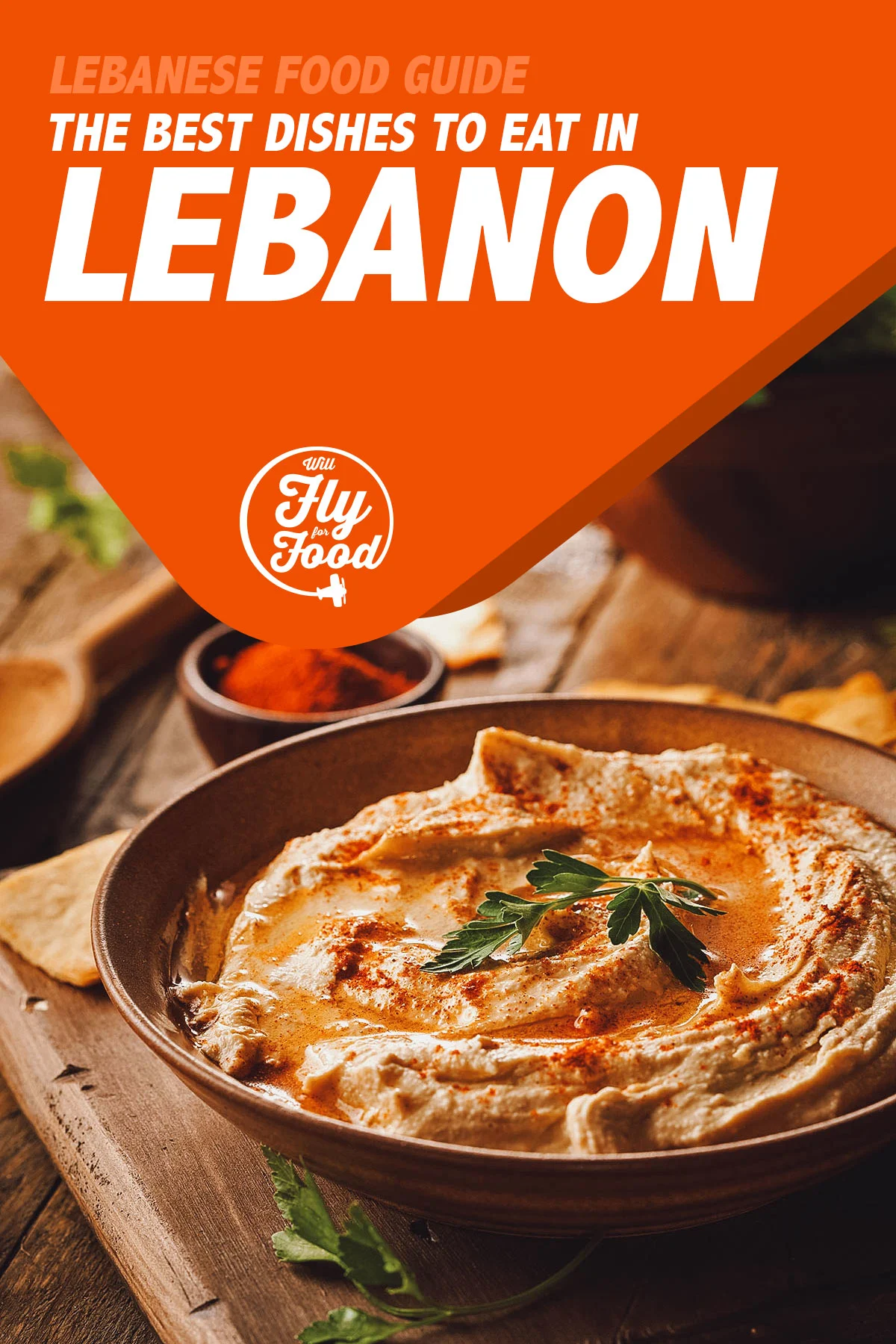
Photo by bhofack2
WHAT IS TRADITIONAL LEBANESE FOOD?
Lebanese cuisine has a long history spanning several millennia. Many Lebanese dishes can be traced all the way back to the eras of Greek, Roman, Persian, and Phoenician rule. In the last half century, it’s been influenced by foreign countries that have held power in Lebanon, most notably Turkey and France.
Whole grains, vegetables, fruits, and seafood figure prominently in the Lebanese diet. Chickpeas and parsley are staple ingredients while garlic, olive oil, and lemon juice are frequently used to flavor dishes. Often, Lebanese foods are grilled, baked, or just lightly cooked in olive oil. Lamb and goat are common proteins though poultry is consumed more often than red meat.
Similar to Spanish tapas, Italian aperitivos, or Korean banchan, mezze forms an important part of Lebanese cuisine. It refers to a series of small dishes served at the start of a meal. When dining at home, mezze platters typically consist of just three or four dishes but at restaurants, it isn’t uncommon to see 20 to 60 different dishes served as mezze.
Mezze can be hot or cold and usually eaten with flatbread like pita. Common mezze dishes include hummus, baba ghanoush, tabbouleh, kibbeh, kafta, and sambousek, all of which are described in more detail in this Lebanese food guide.
THE BEST OF LEBANESE CUISINE
This Lebanese food guide has been organized by category to make it easier to digest. Click on a link to jump to any section of the guide.
BREAD
1. Pita
Pita (or pitta) is the most widely used type of bread in Lebanese cuisine. It refers to a circular leavened wheat flour flatbread that’s common in the Middle East and the Mediterranean. In Greek cuisine, it’s used as a wrap to make gyros and souvlaki.
Also known as Lebanese bread, Arabic bread, or Syrian bread, pita can range in size and thickness and usually contains an interior pocket. It’s usually baked at high temperatures (450–475°F (232–246°C)), turning the water in the dough to steam which causes the pita to puff up and form a pocket. Even after it cools and deflates, the layers remain separated which allows the pita to hold ingredients like a sandwich.
Pita is a versatile bread that can be used in many ways. In Lebanese cuisine, it’s often used as a scoop for dips like hummus and baba ganoush. It can be used as a wrap to make shawarmas or as a pocket to hold falafel. Even leftover pita scraps are fried and repurposed in dishes like fattoush.
RECIPE: Lebanese pita
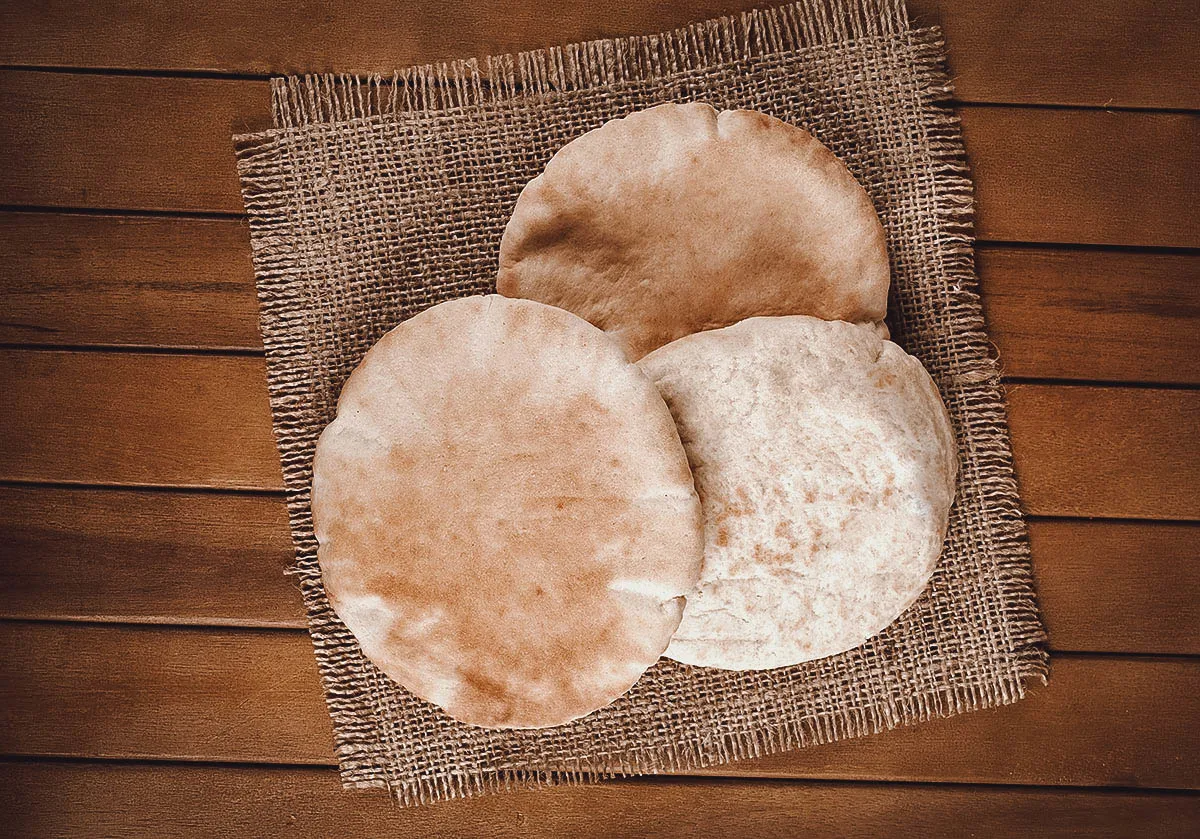
Photo by motorolka
2. Manaqish
Manaqish (or manakish) refers to a Levantine dish made with flatbread topped with different ingredients. You can think of it as an Arabic version of pizza. The name manaqish is rooted in the Arabic verb naqasha which means “to sculpt” or “to carve out”. This is in reference to how indentations are made into the flattened dough for the toppings to sit in.
Manaqish is traditionally made with one of three ingredients – minced lamb, cheese (usually akkawi or kashkaval), or za’atar. The version below is made with za’atar, which is a spice mixture consisting of ground dried thyme, oregano, marjoram, toasted sesame seeds, sumac, salt, and other spices. It’s the most popular form of manaqish and often enjoyed for breakfast, as mezze, or as a snack with feta cheese or labneh (yogurt cheese).
RECIPE: Manaqish
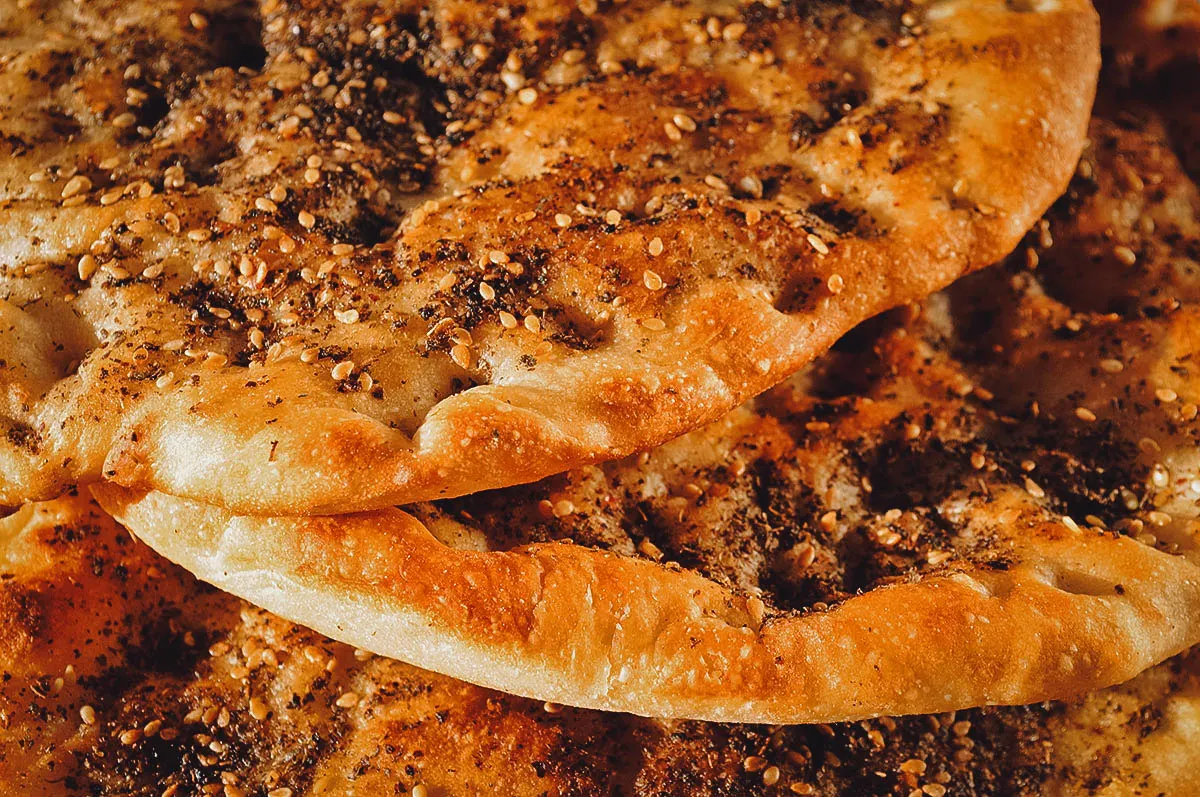
Photo by karammiri
Pictured below is manaqish made with minced lamb, also known as sfiha (or sfeeha, lahmajun, lahmajin). Unlike za’atar manaqish that’s more a breakfast dish or snack, sfiha is a heavier dish that’s typically eaten for lunch.
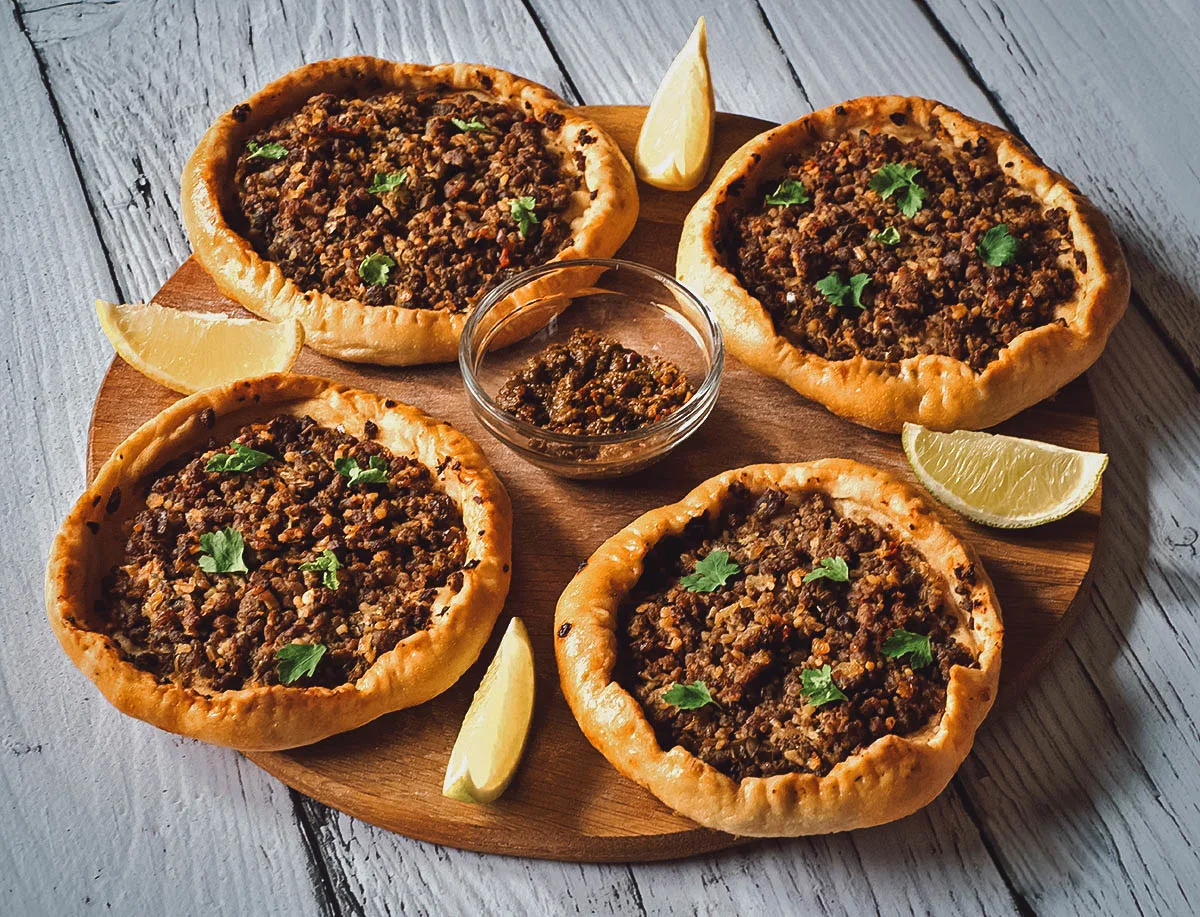
Photo by sablinstanislav
VEGETARIAN
3. Hummus
No self-respecting article on Lebanese food can be complete without hummus, one of the most popular dishes in Lebanese cuisine. It refers to a Middle Eastern dip made with cooked mashed chickpeas, tahini, garlic, and lemon juice. It’s usually served with pita bread and various garnishes like olive oil, whole chickpeas, olives, chopped tomatoes, sumac, or parsley.
Hummus is a staple dish that’s eaten throughout the Middle East, either for breakfast, as mezze, or as an accompaniment to other dishes like falafel, kibbeh, or tabbouleh. It’s become popular in many parts of the world as well and is often the first dish that comes to mind when people think of Middle Eastern cuisine.
Interestingly, Lebanon and Israel have been engaged in a competition to produce the world’s biggest serving of hummus. Both countries regard hummus as a vital symbol of their national identity so winning that title, in their eyes, establishes some measure of ownership over the dish.
The current Guinness World Record is held by Lebanon with their gargantuan serving of hummus weighing in at 10,452 kg (23,042 lbs 12 oz). It was made by around 300 cooks using eight tons of chickpeas, two tons of tahini, two tons of lemon juice, and 70 kilograms (150 lb) of olive oil. It was served on a ceramic plate measuring 7.17 meters (23.5 ft) in diameter.
RECIPE: Lebanese hummus
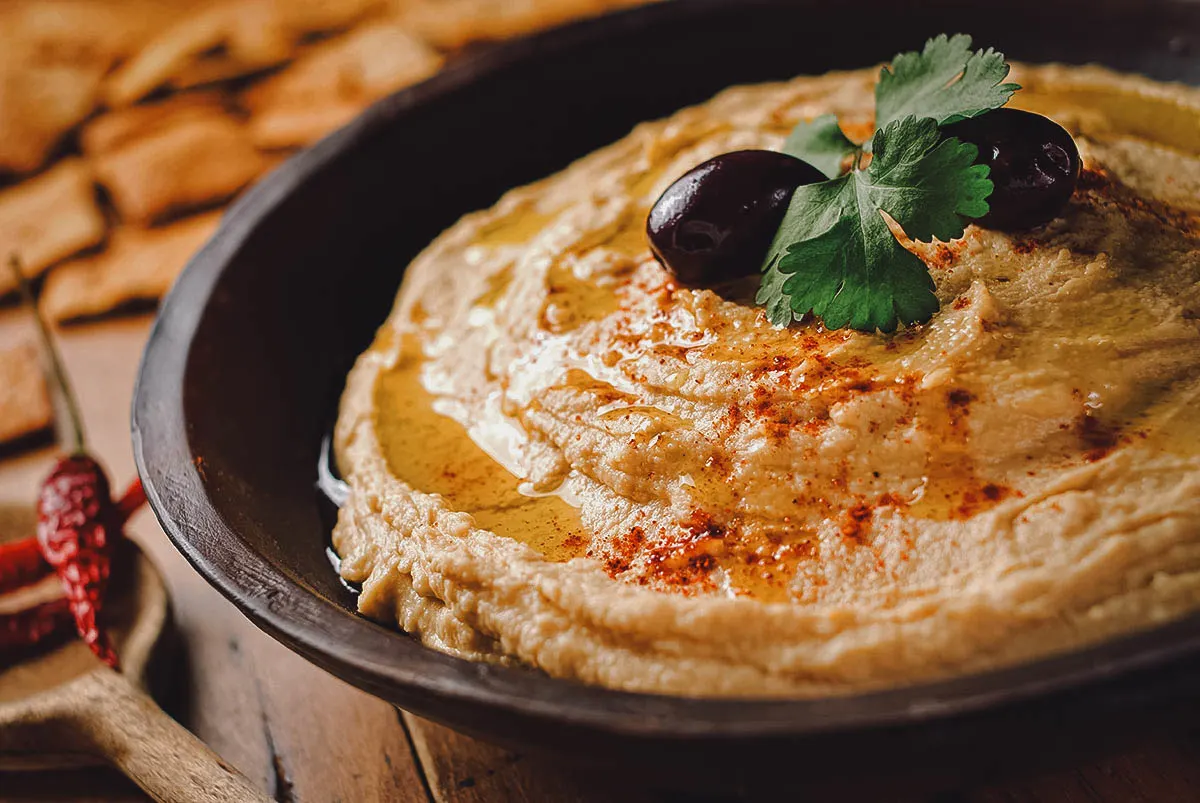
Photo by fudio
4. Baba Ganoush
Baba ganoush (or baba ghanouj) is another Lebanese dip that’s popular throughout the Middle East and beyond. It consists of mashed cooked eggplant mixed with tahini, garlic, lemon juice, olive oil, and different seasonings. Like hummus, it’s typically served as part of a mezze platter with pita bread or as a side dish to larger meals.
Baba ganoush has a wonderful smokey flavor derived from roasted eggplant. To prepare, the eggplant is broiled or roasted over an open flame before being peeled and blended together with the rest of the ingredients.
When eating Lebanese food, you may come across another dip called moutabal. I used to think that moutabal and baba ganoush were completely different dishes but they’re both made from roasted eggplant. Moutabal is basically the spicier version of baba ganoush, made with the addition of pomegranate (anar) seeds.
The name baba ghanoush literally means “spoiled daddy” or “pampered daddy”, though it’s unclear whether this refers to the eggplant itself or an actual person indulged by the dish.
RECIPE: Baba ganoush
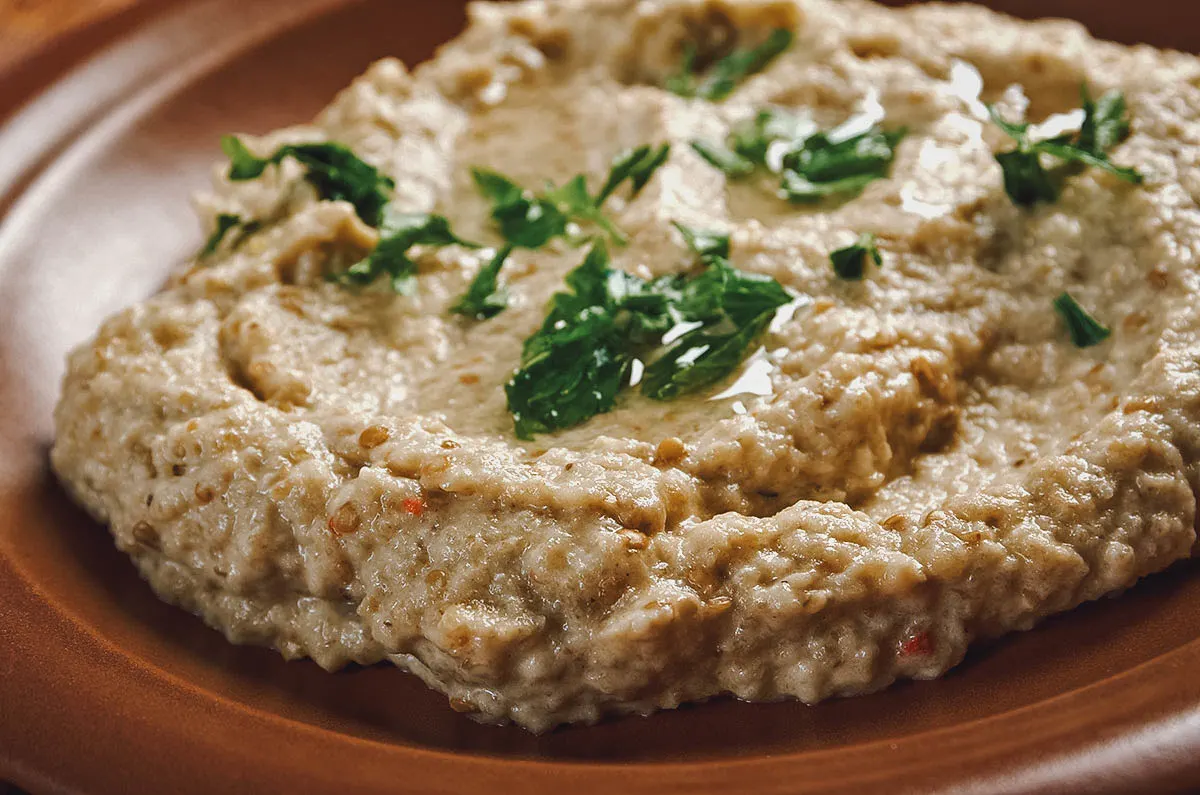
Photo by fanfon
5. Tabbouleh
Tabbouleh (or tabouli, taboulah) refers to a Levantine salad of finely chopped parsley mixed with mint, tomatoes, onions, bulgur, olive oil, and lemon juice. Originally from the mountains of Lebanon and Syria, it’s become one of the most popular salads in Middle Eastern cuisine.
Like hummus and baba ganoush, tabbouleh is often served as part of mezze platters. It’s widely consumed throughout the region and is one of the most well-known Arabic dishes outside of the Middle East. In Lebanon, it’s considered by many to be a national dish.
A common misconception with tabbouleh is that bulgur is the principal component of the dish. It isn’t. It’s just a supporting ingredient with the real star being the finely chopped parsley. Tabbouleh is sometimes served with lettuce leaves that can used as a scoop for the salad.
RECIPE: Tabbouleh
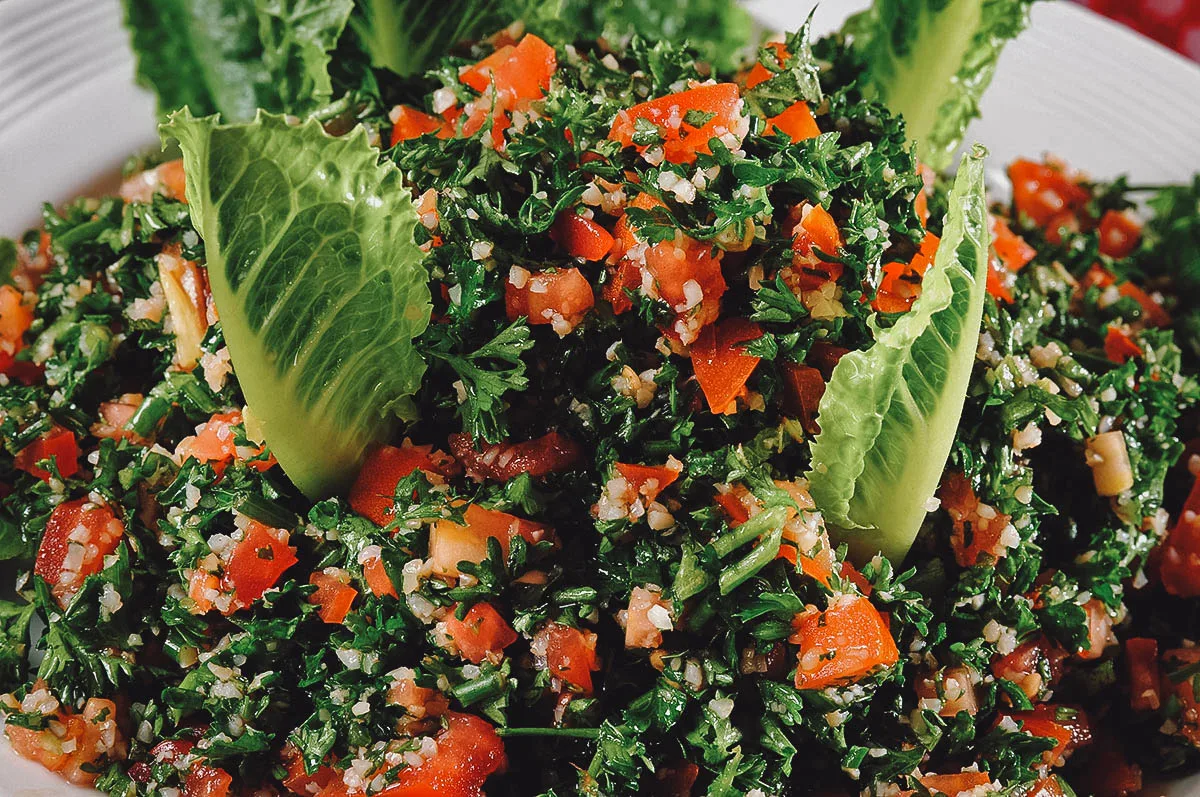
Photo by karammiri
6. Fattoush
Fattoush refers to a Levantine salad made with fried pieces of khubz (Arabic bread) – usually leftover scraps of pita – mixed with different types of greens and other vegetables. It’s a type of fatteh (or fatta) dish – a family of Middle Eastern dishes made with leftover pita and other ingredients that are repurposed to create a new meal.
Fattoush is said to have originated in northern Lebanon. Farmers would fry leftover pita scraps in olive oil and mix them with whatever vegetables and herbs were available. For that reason, fattoush recipes vary but the salad can be made with whatever vegetables are in season. It’s dressed simply, with vinaigrette made with sumac.
Aside from the fried pita, ground sumac is perhaps the most important ingredient in fattoush as it gives the salad its characteristic tart flavor.
RECIPE: Fattoush
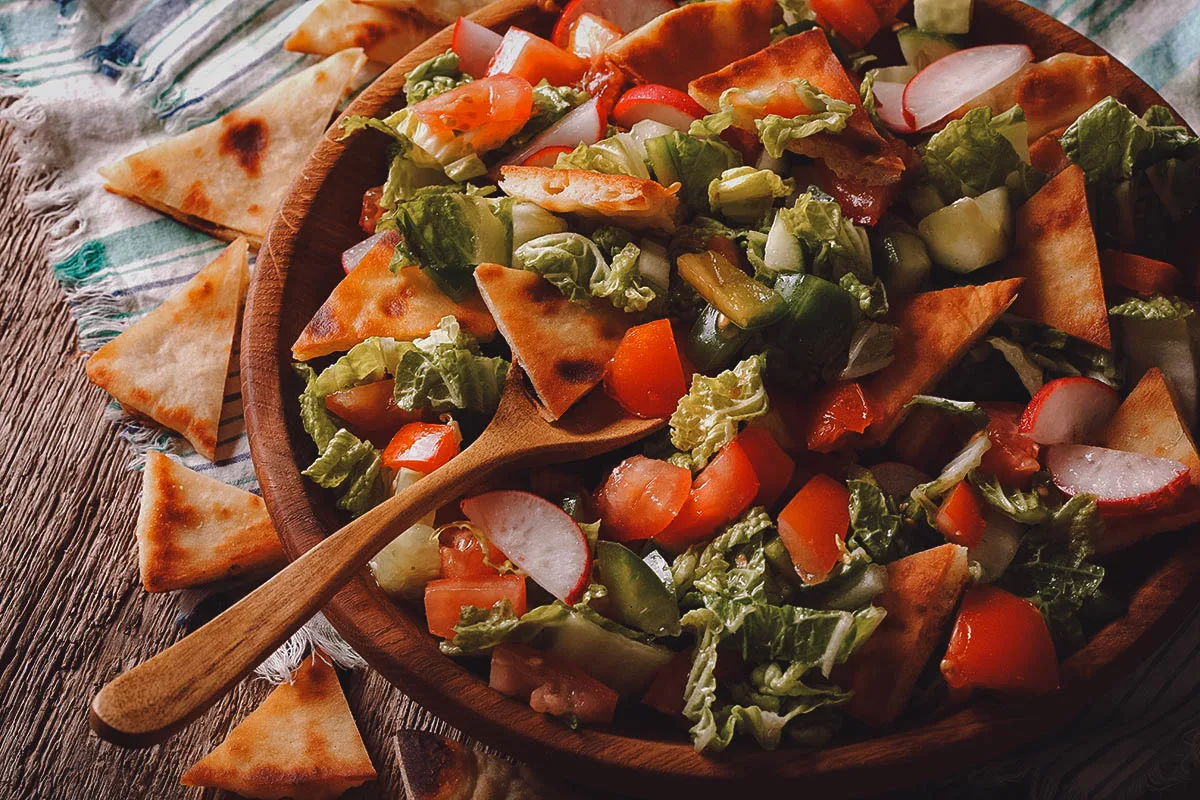
Photo by lenyvavsha
7. Falafel
Falafel refers to a Middle Eastern dish of deep-fried balls or patties made from ground chickpeas (or fava beans), herbs, and spices. Popular throughout the Middle East, they can be enjoyed on their own, as part of mezze platters, or served in pita sandwiches with salad, pickled vegetables, and tahini-based sauces.
Falafel is believed to have been invented in Egypt, as a replacement for meat during times of fasting. It’s a common street food dish and sometimes part of meals that breaks the daily fast during Ramadan (iftar). It’s so popular in Egypt that you can enjoy a McFalafel for breakfast at any McDonald’s in the country.
Egyptian falafel is made strictly with fava beans while falafel in Lebanon, Syria, Jordan, Palestine, and Israel is usually made with chickpeas. Falafel has become a popular vegan dish outside the Middle East as well, particularly in North America where it’s now commonly sold as street food.
RECIPE: Lebanese falafel
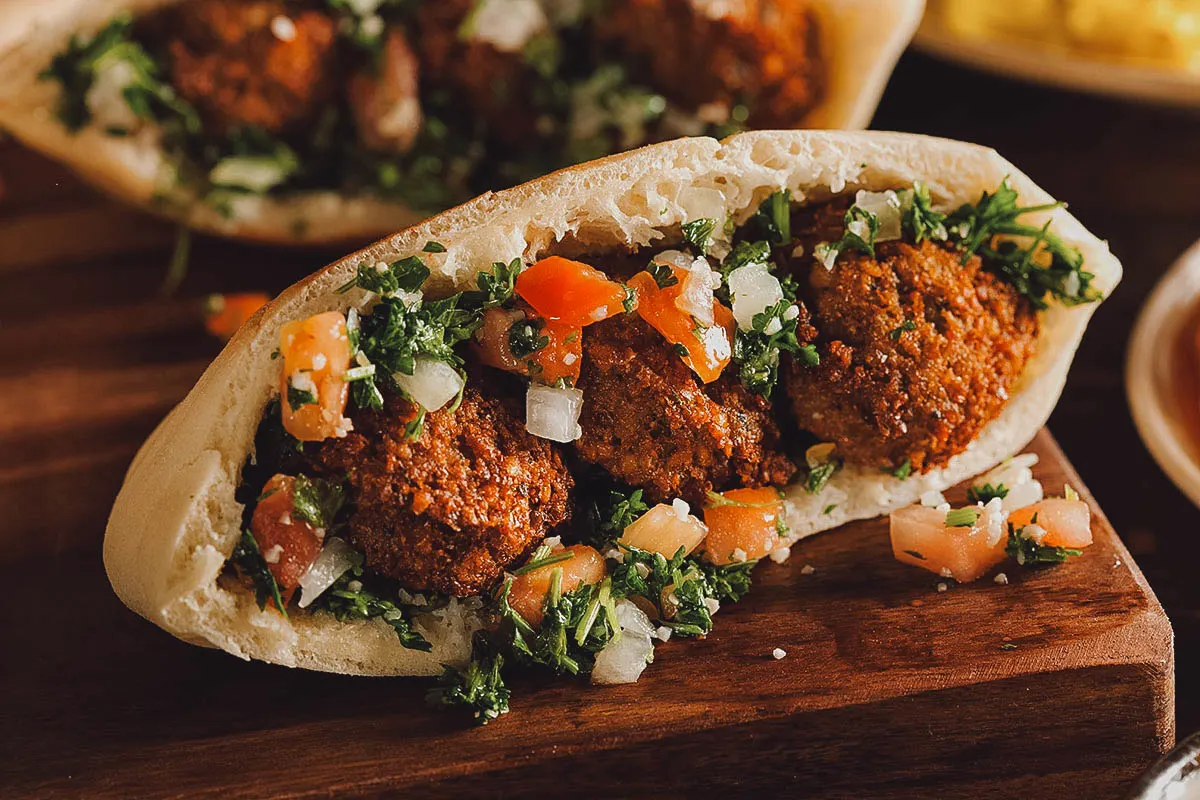
Photo by bhofack2
8. Mujadara
Mujadara is an Arabic dish made with lentils, rice (or bulgur), and caramelized onions. It’s popular throughout the Middle East where it goes by different names like majadra, megadarra, or mudardara.
Mujadara can be prepared in different ways but it’s usually made with brown or green lentils, rice, onions cumin, and olive oil. In some parts of Lebanon, there seems to be a distinction made between versions of the dish containing rice or bulgur. Variations made with lentils and rice are known as mudardara while versions made with lentils and bulgur are known as mujadara.
Mujadara can be served hot or cold, often with yogurt, vegetables, and other side dishes. It was traditionally regarded as peasant food because of how cheap and easy it is to make.
RECIPE: Mujadara
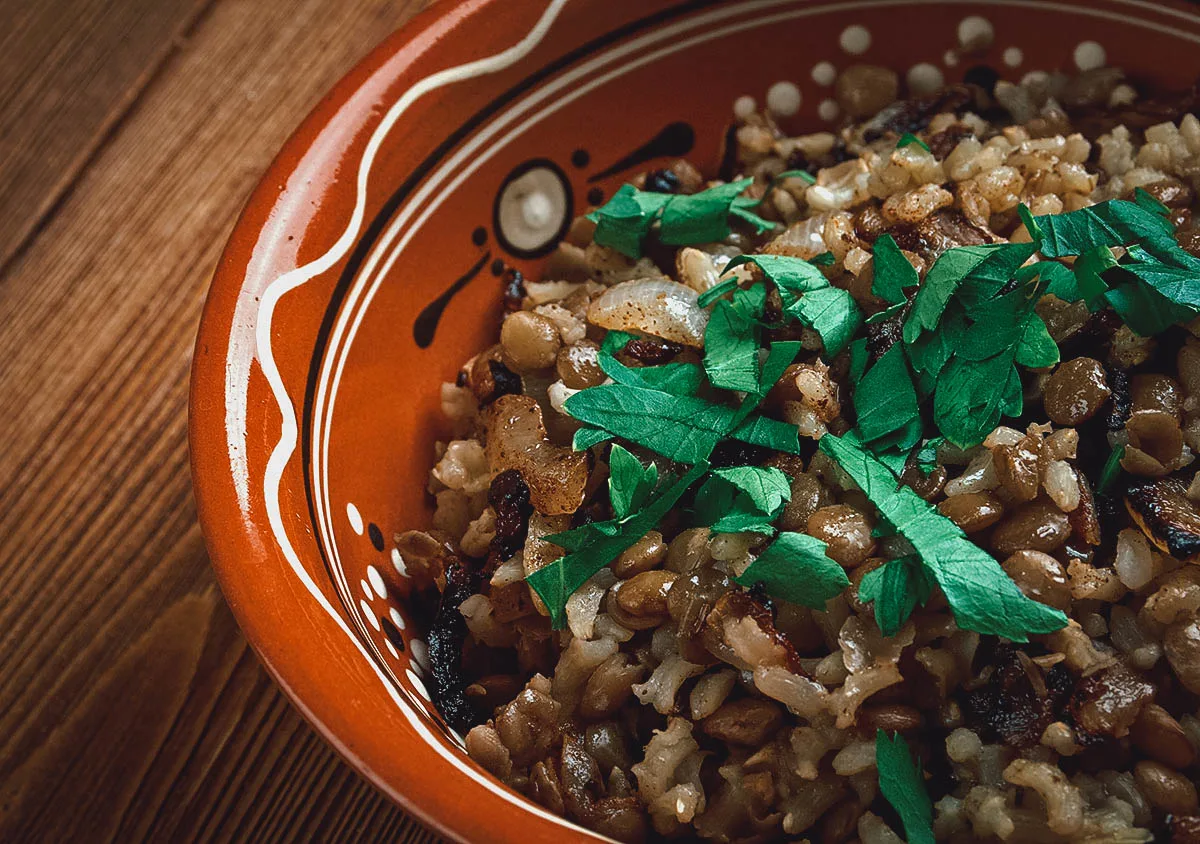
Photo by fanfon
MEAT
9. Warak Enab
Warak enab means “grape leaves” in Arabic and refers to the Lebanese version of dolma (or sarma) – a family of dishes popular in Greece, Georgia, Turkey, and Armenia and in many other countries throughout the Levant, the Balkans, the South Caucasus, and Central Asia.
Warak enab consists of brined grape leaves wrapped around a filling made with short-grain rice, garlic, onion, parsley, and spices like Lebanese seven spice and cinnamon. They can be vegetarian or mixed with a ground meat filling like beef or lamb. Often served as part of mezze platters, vegetarian warak enab are commonly eaten cold while versions made with meat are served hot.
RECIPE: Warak enab
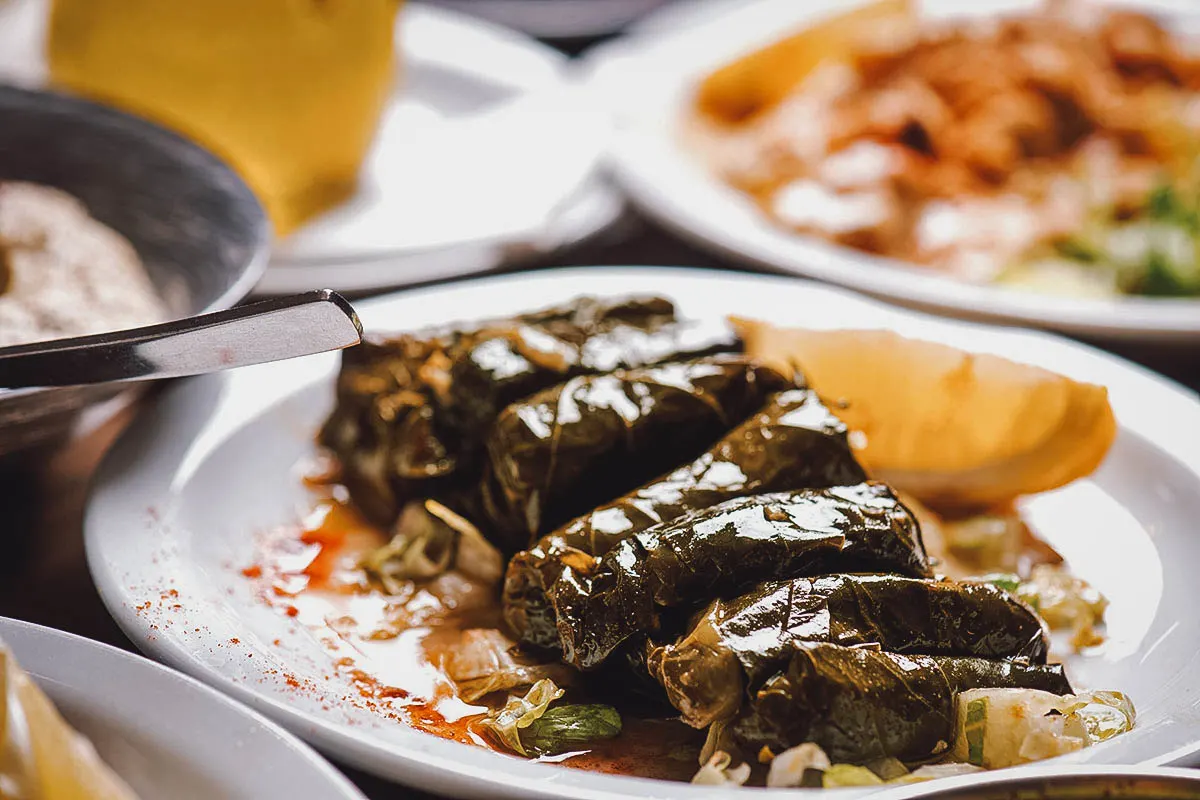
Photo by diplomedia
10. Kousa Mahshi
Similar to warak enab, kousa mahshi refers to another type of stuffed Lebanese dish. Instead of being wrapped in vine leaves, it’s made with squash or zucchini that’s been hollowed out and filled with a stuffing of rice or meat. Vegetarian versions are typically served at room temperature while variations made with meat are served hot as a main course, usually in a garlicky tomato sauce with dried mint.
As described, these stuffed vegetable dishes are popular throughout the Levant, the Balkans, the South Caucasus, and Central Asia where they’re often described collectively as dolma. In some countries, a distinction is made between dishes that are wrapped (sarma) and dishes that are stuffed (dolma).
RECIPE: Kousa mahshi
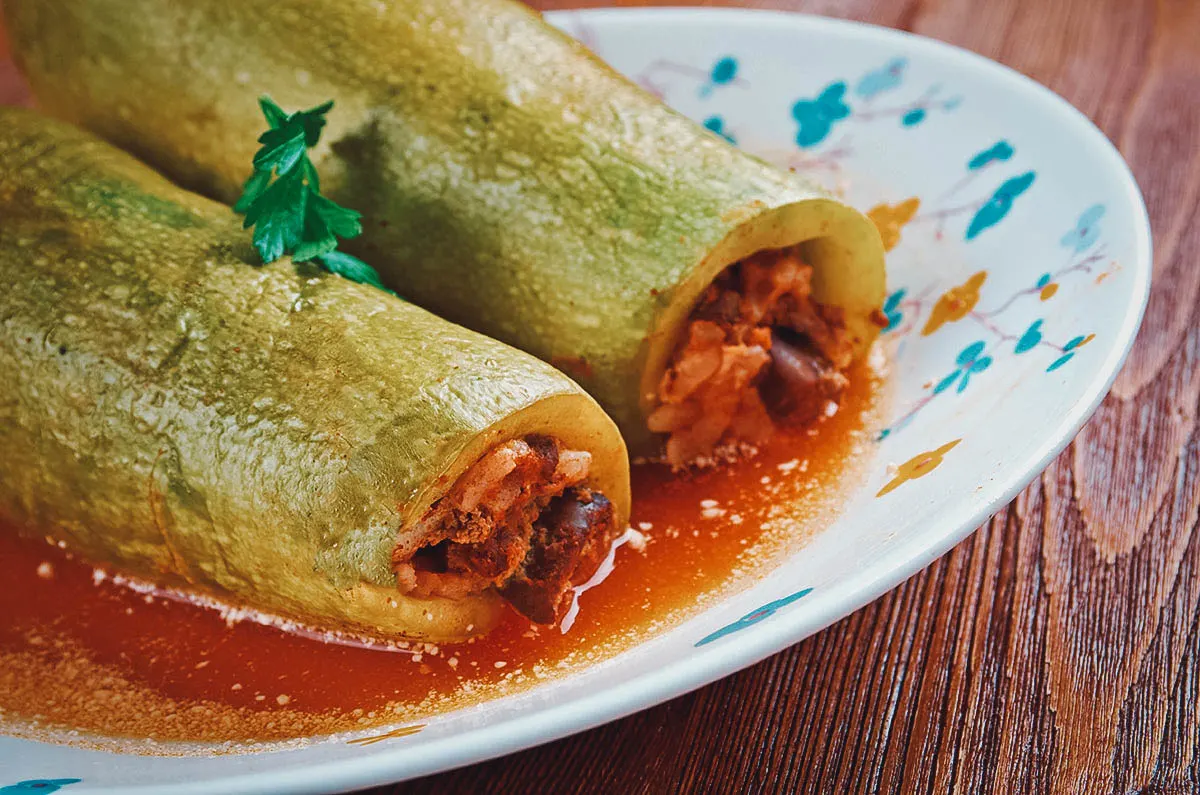
Photo by fanfon
11. Kibbeh
If you like meatballs or croquettes, then you’re probably going to enjoy kibbeh, a Lebanese national dish. It’s like a hybrid meatball-croquette dish made with spiced ground meat, onions, pine nuts, and bulgur wheat. The name kibbeh stems from the Arabic word kubbah, meaning “ball”.
There are many varieties and recipes for kibbeh but it’s usually made by pounding bulgur wheat with meat – usually lamb or beef – into a fine paste. The mixture is then formed into football-shaped orbs with toasted pine nuts and spices like ground cinnamon and allspice before being deep-fried or baked. They’re typically served as part of mezze platters or as a side dish, often with a tahini-based sauce.
Kibbeh is an important dish in Lebanese cuisine, something that many women learn how to make at an early age. Football-shaped kibbeh are some of the most recognizable but they can be formed into balls or patties as well. Some are even eaten raw (kibbeh nayyeh) like steak tartare or incorporated into soups.
Kibbeh is a Levantine dish but it’s become popular throughout Latin America and in parts of North America as well. Thanks to Middle Eastern immigrants, kibbeh has found its way into the cuisines of countries like Brazil, Colombia, and the Dominican Republic.
RECIPE: Kibbeh
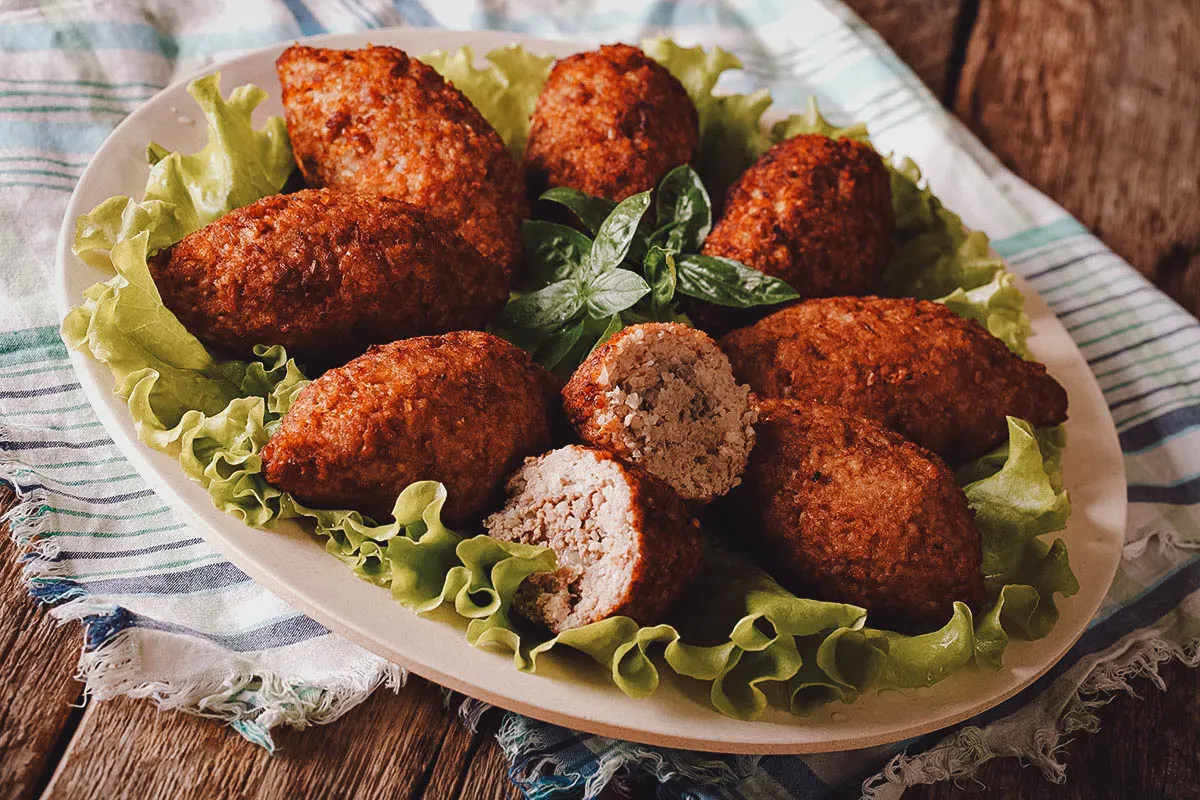
Photo by lenyvavsha
12. Sambousek
If you like Indian samosas or Latin American empanadas, then you’re going to love sambousek. It’s a small Lebanese meat pie or turnover that’s widely consumed throughout the Middle East, South Asia, Southeast Asia, Central Asia, and Africa. It exists in many forms and goes by different names like sambosa, sambusak, sambuseh, and samsa.
In Lebanon, sambousek is traditionally filled with either pre-cooked ground beef or lamb or some type of cheese like feta or kashkaval. When made with cheese, it often contains spinach as well. The filling is wrapped inside dough that’s folded and pinched shut into a crescent shape before being deep-fried or baked. Commonly served as mezze, sambousek is especially popular during the holy month of Ramadan.
Sambousek has a long history that dates back to the 10th century Middle East. It’s earliest mention was in an Iranian history book where it was referred to as “sambosa”. This early version is generally considered to be the predecessor of similar savory pastries like the samosa, empanada, and Italian calzone.
RECIPE: Beef sambousek
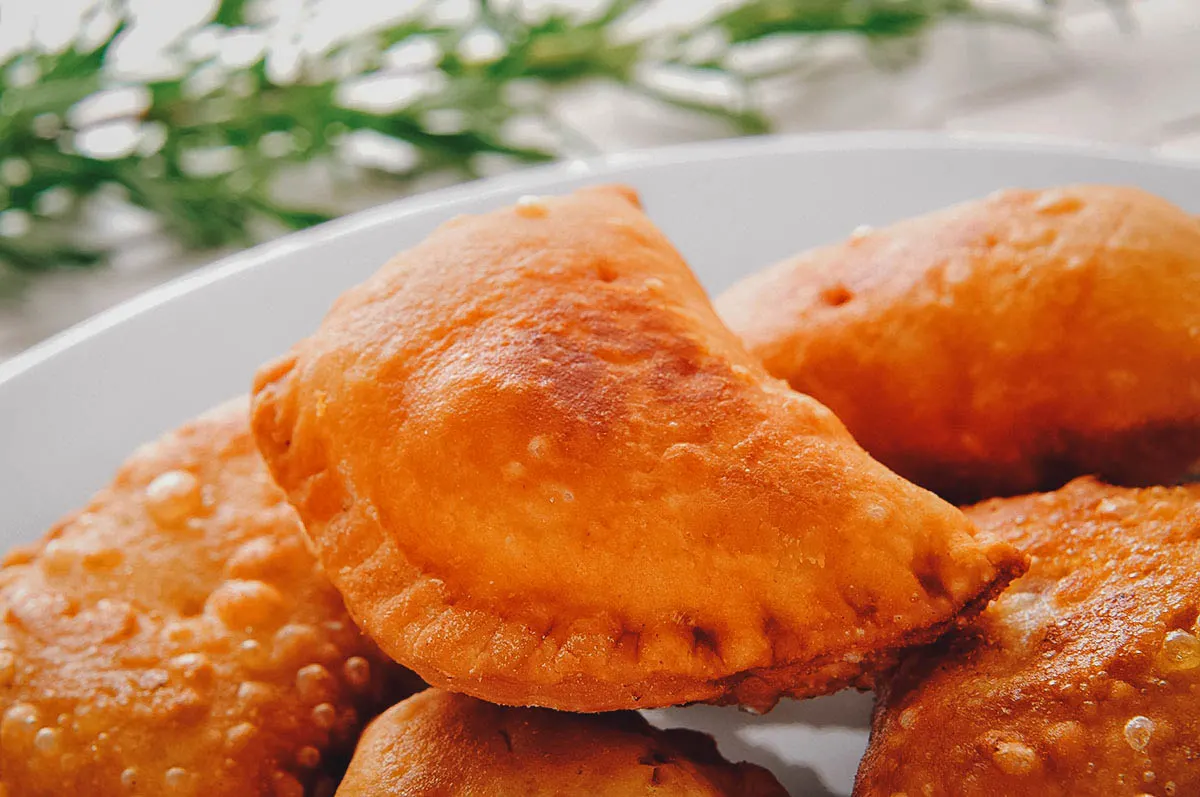
Photo by nito103
Lebanese sambousek is often crescent-shaped, like an empanada, but it can be made into other forms as well depending on where it’s from and the type of dough used to make it.
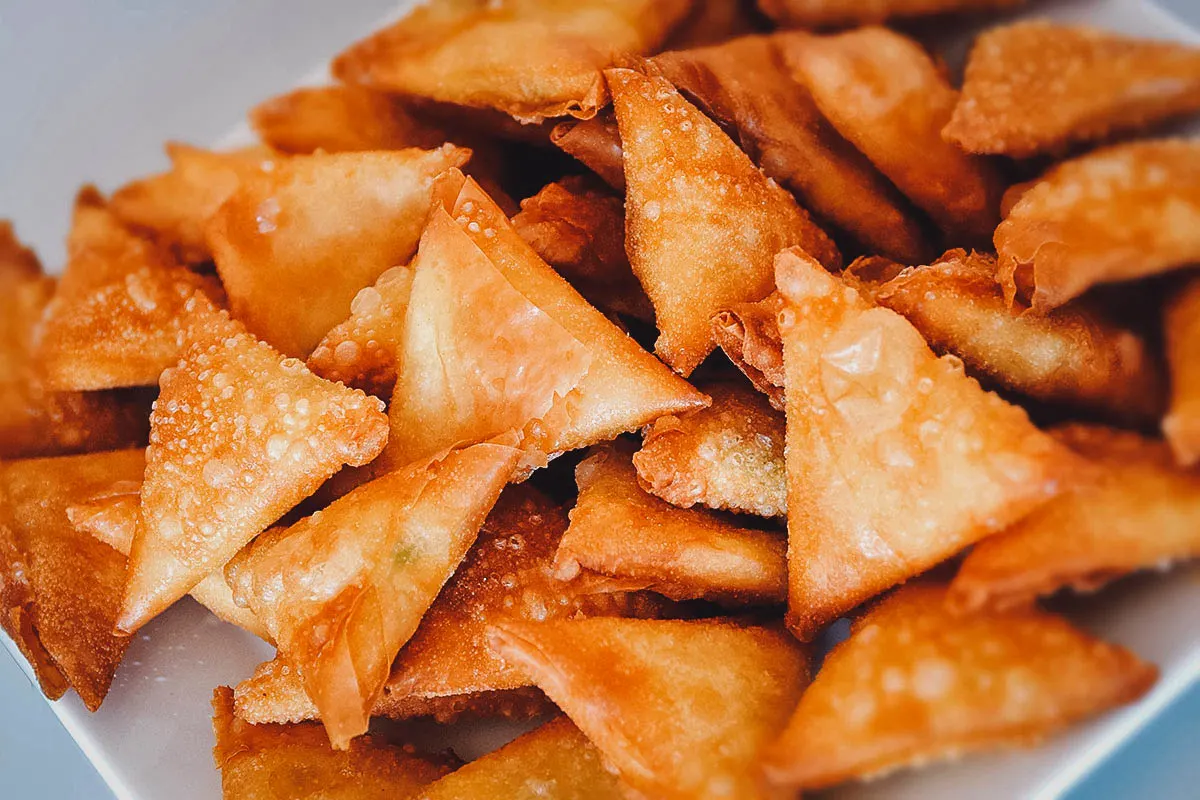
Photo by fermate
13. Shawarma
Shawarma is one of the most internationally well-known Lebanese foods. Commonly sold as street food throughout the Middle East and beyond, it refers to a Levantine dish made with heavily-marinated meat – usually chicken, beef, lamb, or mutton – cooked on a vertical rotisserie.
Like Greek gyros and Mexican tacos al pastor, the Lebanese shawarma is a descendant of the Turkish doner kebab. To make it, thin slices of marinated meat are pierced and stacked onto a skewer. As the stack gets taller, larger pieces of meat are layered to create a cone-like shape measuring about 60 cm (20 in) high. A motorized spit then slowly turns the cone to roast the outer layer against a vertical heating element.
Once cooked, thin slices of meat are shaved off and served in a pita sandwich or wrap with tomatoes, onions, cucumbers, french fries, and tahini-based sauces. Shawarma was traditionally made with lamb, mutton, or chicken but it can now be made with other types of meat as well like beef or turkey.
Like hummus and falafel, shawarma has become one of the most popular Lebanese foods in the world. Personally, it’s one of my favorite comfort foods, on par with pizzas and burgers.
RECIPE: Lamb or beef shawarma
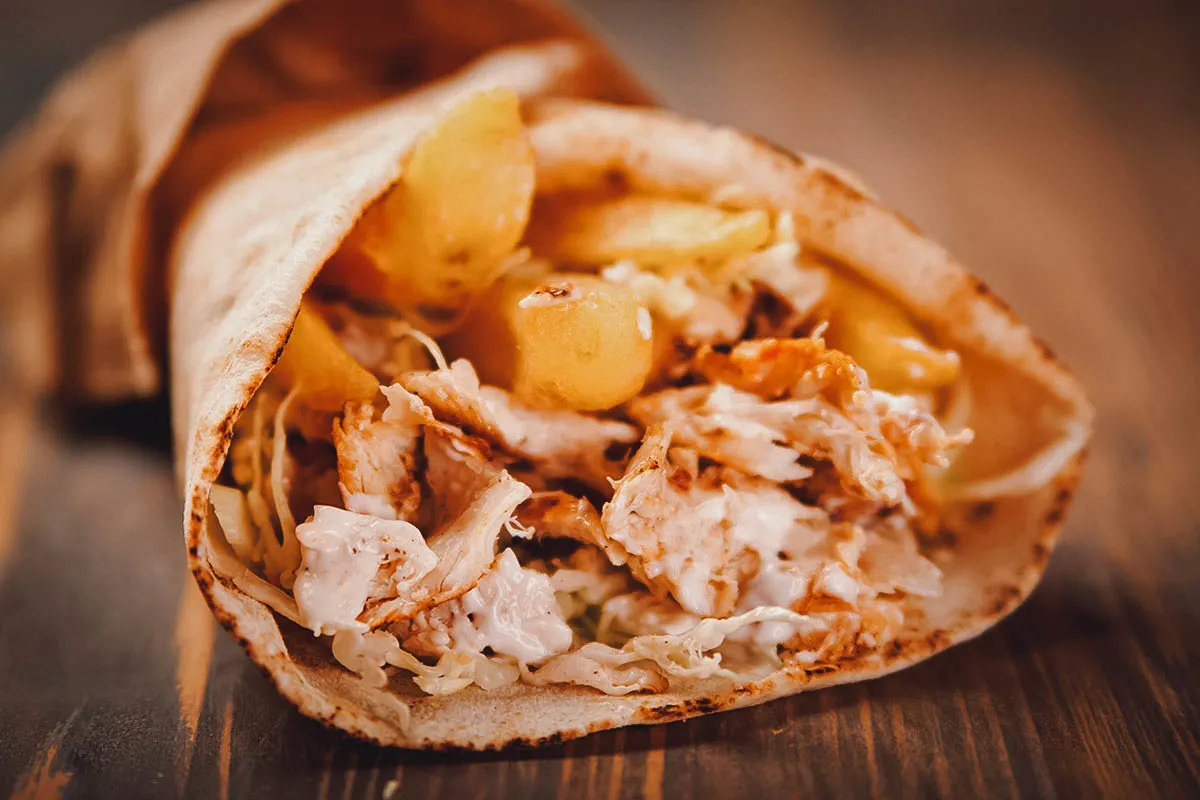
Photo by chirapbogdan
14. Kafta
Kafta (or kofta, kufta) is a type of Lebanese kebab or meatball made with ground meat, onions, parsley, and spices. It’s popular in many countries throughout the Middle East, Central Asia, the Balkans, the South Caucasus, and the Indian subcontinent.
Recipes for kafta vary but it’s typically made with ground meat – usually beef or lamb – mixed with finely chopped parsley, onions, black pepper, salt, and seven spice. The mixture is then formed into patties or shaped over skewers before being grilled over charcoal with tomatoes, onions, and potatoes. It’s typically eaten with rice or pita bread and often served with hummus, fattoush, or tabbouleh.
Lebanese kafta is most commonly grilled but it can be prepared in other ways as well. It can be sautéed, cooked in stews, used as a filling for pitas (arayes), or even eaten raw.
RECIPE: Beef kafta
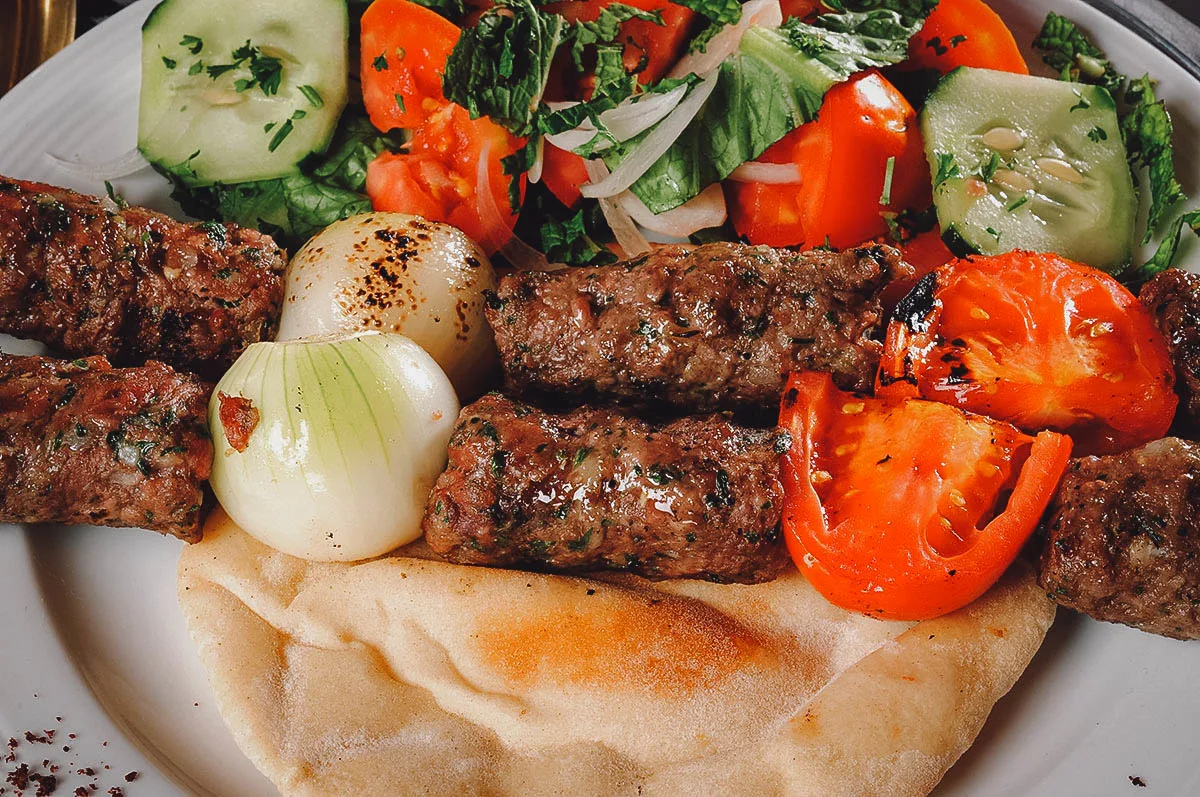
Photo by karammiri
15. Shish Taouk
Shish taouk (or shish tawook) refers to a type of chicken shish kebab. It’s originally a Turkish dish that’s become popular in Lebanon and throughout the Middle East. In Turkish, shish means “skewers” while taouk is derived from tavuk, meaning “chicken”.
To prepare, cubes of chicken are marinated in garlic, lemon juice, yogurt, and spices before being skewered and grilled with onions and tomatoes. It can be served on a platter with rice and salad or in sandwich form wrapped with vegetables in pita. No matter how you have it, it’s almost always seved with toum or Lebanese garlic sauce.
As much as I love hummus and shawarma, shish taouk in sandwich form may be my Lebanese GOAT dish (Greatest Of All Time). It’s disgustingly delicious.
RECIPE: Shish taouk
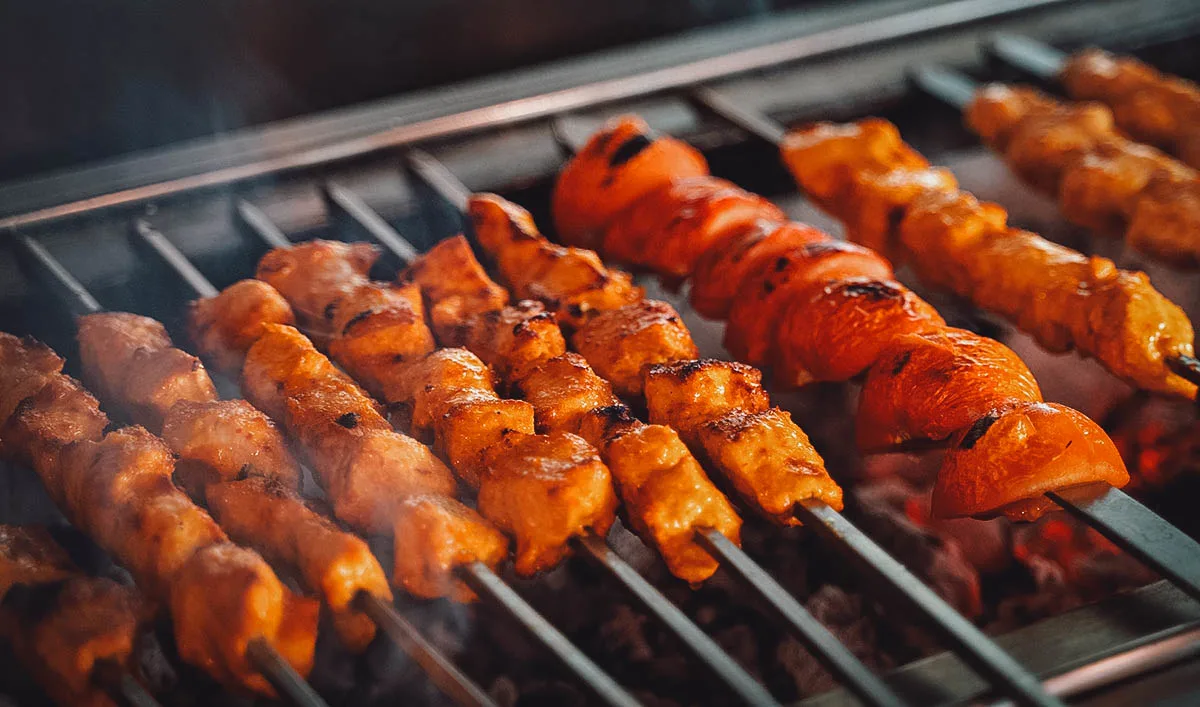
Photo by [email protected]
DESSERT / DRINKS
16. Maamoul
Maamoul is a type of Lebanese shortbread cookie. It’s traditionally filled with dates but it can be made with nuts like almonds, walnuts, or pistachios as well. They can be shaped simply by hand or molded into more intricate patterns using special molds carved into wood.
Maamoul cookies are typically made around Eid or Easter. It’s unclear why they’ve become associated with the holidays, but it’s been suggested they may be a symbolic sweet treat or reward to celebrate the end of a difficult fast.
RECIPE: Maamoul
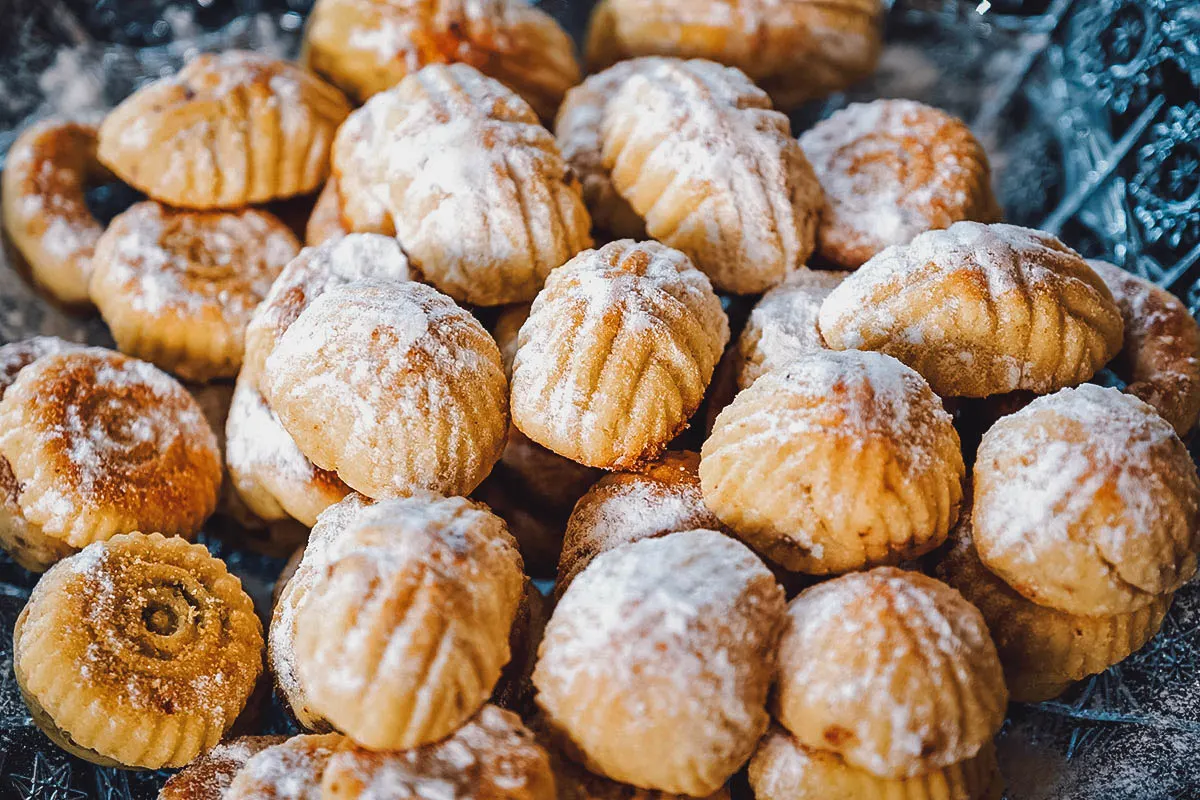
Photo by dieasaob
17. Baklawa
No, that isn’t a typo. Baklawa (or batlawa) is the Lebanese version of the more commonly spelled baklava, a popular dessert made with many layers of filo pastry, chopped nuts, butter, and syrup.
Other than the spelling, Middle Eastern baklawa differs from the Greek version in the type of syrup used. Instead of a honey-based syrup, it’s made with a rose water / orange blossom sugar syrup called atter. It’s lighter and isn’t as syrupy sweet as baklava.
No matter how it’s made, this filo pastry dessert is widely consumed in many countries throughout the Mediterranean, the Balkans, the Middle East, the South Caucasus, and Central Asia. It’s exact origins are unclear though its present version may have been invented in the kitchens of the Ottoman Empire.
RECIPE: Baklawa
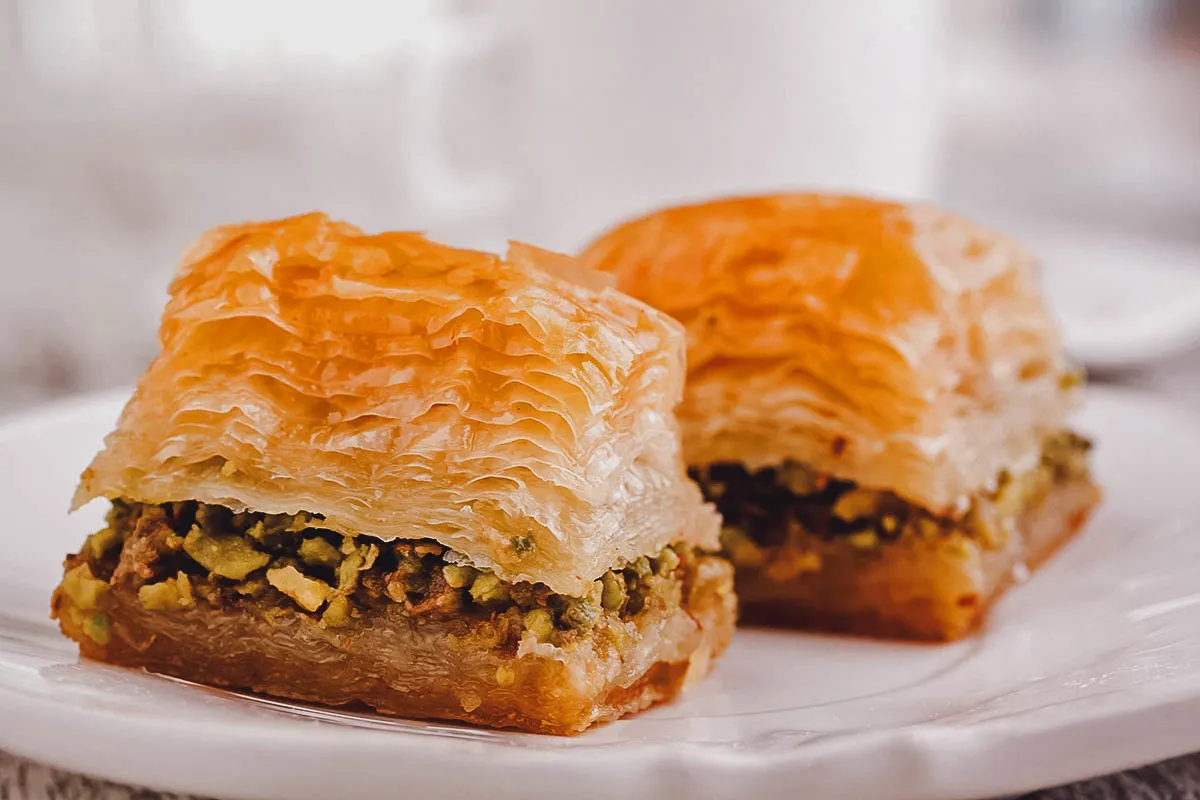
Photo by Bernashafo
18. Kanafeh
Kanafeh is a popular Middle Eastern dessert made with shredded filo dough soaked in sweet syrup and layered with cheese. Depending on where it’s from, it can be topped with additional ingredients like pistachio nuts or clotted cream.
Kanafeh is popular throughout the Middle East, the Balkans, the Mediterranean, and the South Caucasus where it goes by different names like kunefe, kataifi, knafeh, and konafa. Like baklawa, it’s exact origins are unclear and often the subject of debate.
No matter where it’s from or what it’s called, one thing is clear, you absolutely need to try kanafeh. It’s served piping hot so the cheese comes away in delicious gooey strings. It’s fantastic and one of my favorite desserts from any culture.
RECIPE: Lebanese kanafeh
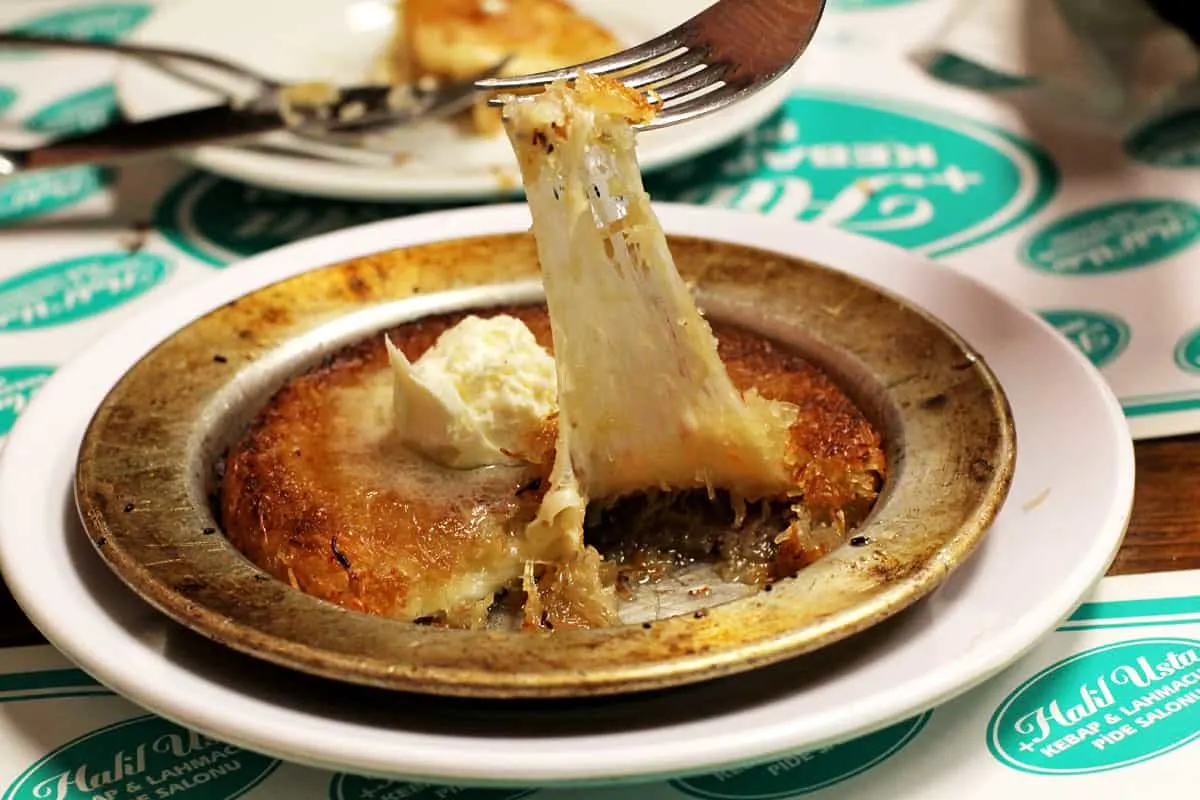
19. Jallab
Jallab is a Lebanese drink made with grape molasses, dates, and rose water. The mixture is diluted in water and served in a glass with crushed ice, pine nuts, and golden raisins. It’s a refreshing brew that’s a favorite drink to cool off with in the summer.
RECIPE: Jallab
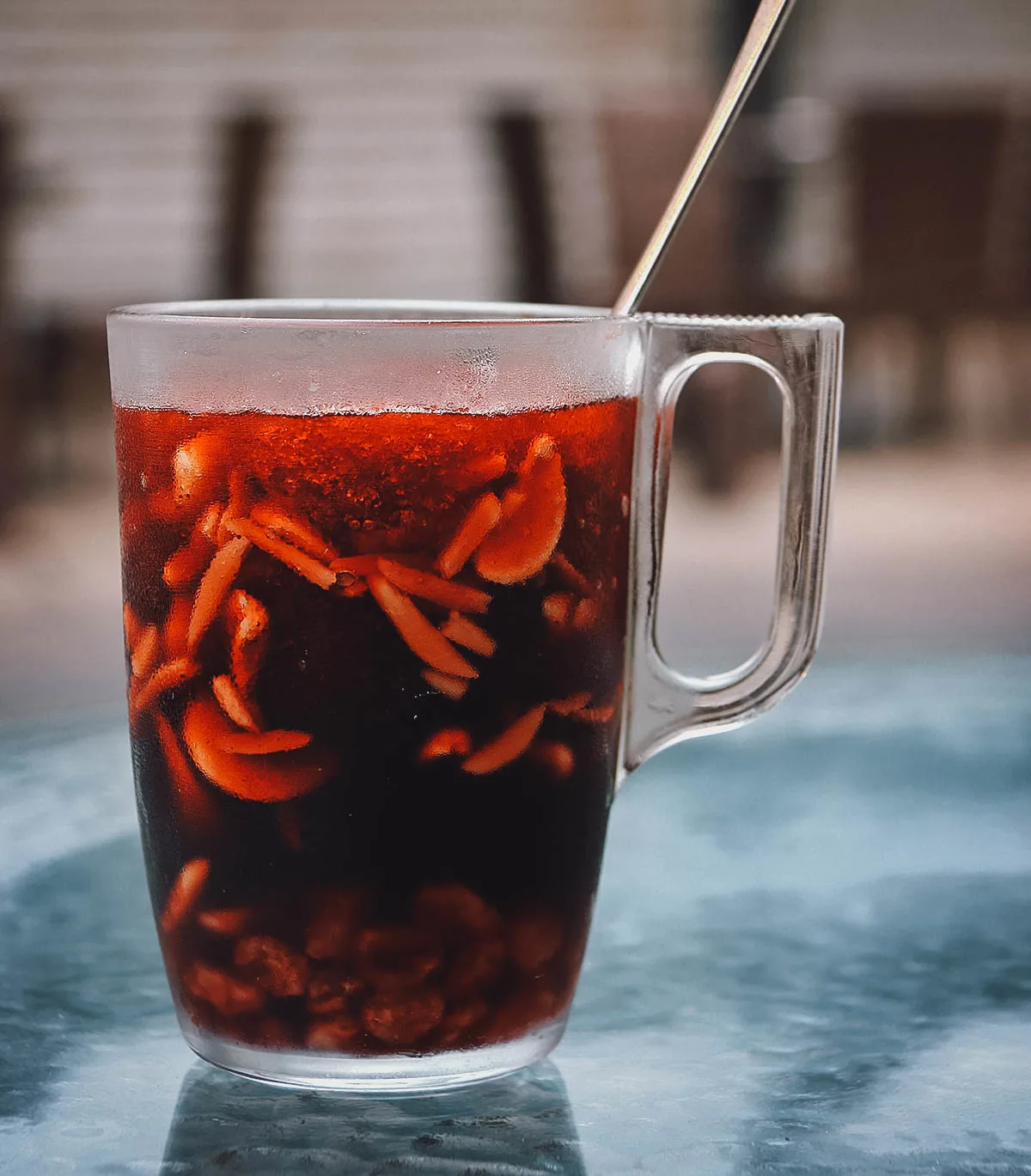
Photo by ElianeHaykal
20. Arak
Arak (or araq) is Lebanon’s national drink. It refers to a distilled spirit made with just two ingredients – grapes and aniseed. Known for its cloudy appearance and licorice flavor, it’s a popular unsweetened spirit that’s often enjoyed at Lebanese social gatherings and celebrations.
Arak is strong – about 40-63% ABV – so it’s often mixed with water and ice to dilute it. It’s potency and milky white appearance have earned it the nickname “the milk of lions” in the Middle East.
RECIPE: Arak cocktails

Photo by [email protected]
FINAL THOUGHTS ON LEBANESE FOOD
Nothing beats having Lebanese food in Lebanon. But thanks to globalization and the Lebanese diaspora, many people can enjoy the wonders of Lebanese cuisine in the comforts of their own city. Like Italian or Japanese food, the fact that it’s become so widely accepted internationally speaks volumes about how special Lebanese food really is.
Cover photo by bhofack2. Stock images via Depositphotos.


Nour
Wednesday 24th of May 2023
Lebanese food is the best purrrr.
Jeanette Nayfa McQuitty
Saturday 22nd of April 2023
I grew up eating my Lebanese mother's native dishes shown on your web site and did not know how lucky I was. I envied my hotdog/hamburger, french fries-eating friends, not realizing that my mother's meals were a gourmet's delight. I loved the kenefeh that she improvised with shredded wheat and the kibbeh with spices and great pine nuts. I'm sure she had to improvise, but she managed to keep the traditional flavors alive!
JB & Renée
Sunday 21st of May 2023
Thank you for sharing Jeanette! I was the same. As a child, I craved for the Western food I saw on TV but it was only as an adult that I truly appreciated my home country's cuisine. So much more interesting than American fast food!
Melissa
Friday 24th of March 2023
We love the article and mostly the pictures were amazingly taken! Is there a way we can save these photos and share them with friends and family? Do we need approval for this?
JB & Renée
Wednesday 29th of March 2023
Hi Melissa, as long as you don't post them online anywhere or use them commercially, then that should be fine. Happy you enjoyed the article!
Chef
Wednesday 27th of July 2022
Lovely recipes, and all the Lebanese food.but clear me about kibbab.
Robert H
Wednesday 2nd of March 2022
Fantastic and well researched overview of popular lebanese dishes. Good job. Your passion for good Lebanese food (and drink) comes through distinctly. I love your comment about Tabbouleh being primarily about the parsley--so true, as often what is sold as tabbouleh in western delis is primarily bulgur (or couscous) with (if you are lucky) a hint of parsley!
JB & Renée
Tuesday 8th of March 2022
Happy you enjoyed the article Robert! Absolutely love Lebanese food.